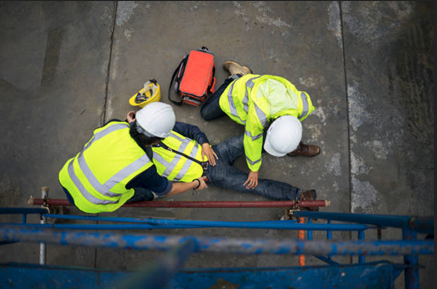The Strategic Edge: Beyond Compliance in Workplace Incident Reporting
Incident reporting isn't just about compliance. Learn how it becomes a strategic tool for foresight, better safety, and a stronger, more trusted workplace culture.


Feeling confident in your understanding of the strategic incident reporting? Test yourself against this interactive scenario! But be warned, reading the article first is recommended...
Workplace incident reporting. The phrase often conjures images of bureaucratic forms, regulatory checkboxes, or simply reacting to a crisis. It's seen as a necessary evil, an administrative task required by law to tick compliance boxes and prevent recurrence.
Can we reframe this? What if incident reporting isn't merely about ticking boxes, but about unlocking foresight, building resilient cultures, and fostering a strategic advantage? The truth is, the most forward-thinking organisations don't just report incidents; they leverage them as crucial data points to sculpt a safer, more productive, and fundamentally stronger workplace.
Let's dissect the profound implications that shift incident reporting from a chore to a critical strategic asset.
1. From Legal Burden to Imperative Insight
Yes, the immediate trigger for incident reporting often stems from strict legal obligations. In Australia, the Work Health and Safety (WHS) Act 2011 mandates immediate notification of "notifiable incidents"—deaths, serious injuries, or dangerous exposures—to state or territory WHS regulators. Failure to comply can result in catastrophic financial repercussions: for Category 1 offences, where an employer recklessly exposes an individual to death or serious injury, fines can reach up to $11.5 million for corporations and $2.3 million for individuals. Even lesser offences (Category 3) can incur penalties up to $776,000 for businesses.
However, viewing this purely as a risk to avoid misses the forest for the trees. These staggering penalties aren't arbitrary deterrents; they underscore the societal and financial cost of systemic safety failures. Regulators aren't just collecting reports for their files; they aggregate this data to identify hazardous trends across industries. By requiring thorough reporting, they effectively turn individual incidents into collective learning opportunities for the entire economy. A robust reporting system doesn't just shield your company from fines; it indirectly contributes to a safer national working environment.
2. Data as Foresight: The Predictive Power of Every Report
The real transformation begins when reporting is viewed as intelligence gathering. Every reported event, from a dropped tool to a serious laceration, is a piece of data. When aggregated, these dots begin to connect, revealing patterns of risk that were previously invisible.
Unmasking Hidden Hazards
What often seems like an isolated "one-off" incident might, through consistent reporting, be identified as a recurring failure linked to specific equipment, a flawed process, or inadequate training. The sheer volume of minor slips in a particular hallway, seemingly insignificant on their own, can collectively point to an underlying structural issue or a maintenance deficiency. This is how data turns anecdotal observations into quantifiable risks.
Decoding the Near-Miss
Perhaps the most undervalued data point is the near-miss. No harm occurred, so why report? Because the near-miss is a potent alarm bell, detailing how a sequence of failures almost resulted in catastrophe. These events offer critical insights into potential system weaknesses without the high human or financial cost of an actual injury. Reporting them aggressively provides an invaluable "dress rehearsal" for disaster prevention, allowing proactive interventions that target root causes before tragedy strikes. Thinking like this shifts the safety paradigm from reactive damage control to proactive risk prediction.
Beyond the Superficial
A thorough report, capturing context and contributing factors, enables deep root cause analysis. It moves beyond identifying what happened to understanding why it happened at a fundamental level. Was it purely human error, or was that error facilitated by poor equipment design, insufficient training, or a pressured work environment? Maintaining diagnostic capability is what allows you to implement long-lasting solutions, moving beyond generic safety campaigns to laser-focused interventions.
3. Cultivating a Culture of Trust & Relentless Improvement
The true heart of effective incident reporting lies in its ability to shape organisational habits. It's not just a process for managers; it's a vital communication channel for every employee.
Empowering the Workforce
A genuine incident reporting system cultivates a bedrock of trust. When employees know their concerns will be heard, that blame will be avoided for reporting, and that issues will be genuinely acted upon, it transforms a natural fear of repercussions into confidence that their voices matter. This empowers the workforce to become active participants in safety, vigilant against hazards, and proactive in reporting them, rather than simply bystanders waiting for something to go wrong.
From Blame to Learning
Companies often pay lip service to "learning from mistakes." Incident reporting provides the structured mechanism to actually do it. By formally documenting incidents and their resolutions, you create transparency that holds everyone accountable - from frontline workers to senior leadership. This isn't about finger-pointing; it's about identifying systemic weaknesses. Leadership's response to reported incidents sets the tone. When reports lead to constructive analysis and tangible improvements, it reinforces a learning culture over a blame culture, fostering psychological safety where individuals feel safe to admit errors and contribute to solutions.

Enhancing Wellbeing & Morale
Ultimately, a workplace that actively, visibly, and effectively responds to incident reports demonstrates that it sincerely values the health and wellbeing of its people. This proactive commitment isn't just about preventing physical harm; it profoundly impacts employee morale, confidence, and loyalty. Knowing that their employer is consistently working to eliminate hazards - from the everyday trip hazard to the rare catastrophic risk - builds a palpable sense of security and belonging. This, in turn, boosts productivity, reduces absenteeism, and strengthens employer branding.

Incident Reporting as a Strategic Imperative
When meticulously integrated into an organisation's operational fabric, incident reporting steps past its basic definition. It becomes a strategic asset, providing invaluable data-driven foresight, fostering a deeply engaged and trusted workforce, and embedding a culture of relentless improvement. Every structured report builds your wealth of understanding about the guts of your organisation.
This isn't merely about avoiding legal pitfalls or ticking boxes; it's about systematically stripping away risk, building unparalleled resilience, and ensuring a workplace where safety is not just an aspiration but a lived reality – for competitive advantage and the sustained wellbeing of every individual.
What about myosh?
Reporting can be tedious and disorganised. The more tedious, the less thorough; the more disorganised, the less likely your data will have the consistent structure needed for proper analysis. The Incident Reporting software on the myosh safety management platform has been honed over decades of user feedback. Not merely in the design of the standard template but in the underlying engineering of the unmatched flexibility and user-based configurability of the system. Your HSEQ system should mould to your specific needs and allow you to chip away at points of friction that come in the way of effecting reporting.
Author
Adrian Manessis
Adrian has been a Director at myosh for 20 years, overseeing the implementation of safety management software in various companies, from small firms to multinational corporations. His roles have included Training, Support, Development, Analysis, Project Management, and Account Management. Adrian’s experience provides him with extensive knowledge of health, safety, environment, and quality management, focusing on industry-specific needs. He also helps integrate the latest industry practices into myosh’s products by building relationships with experts and hosting educational webinars.







